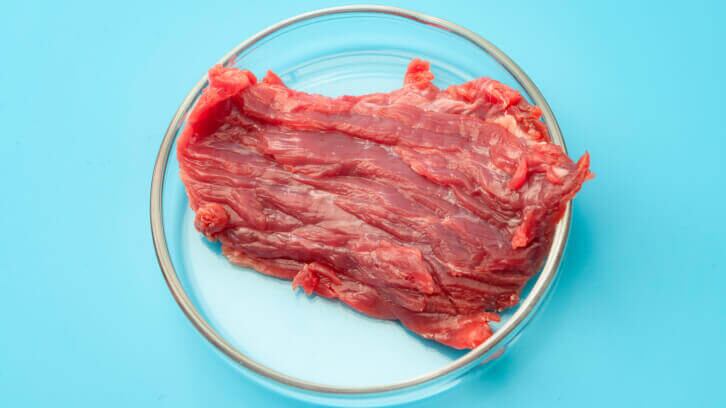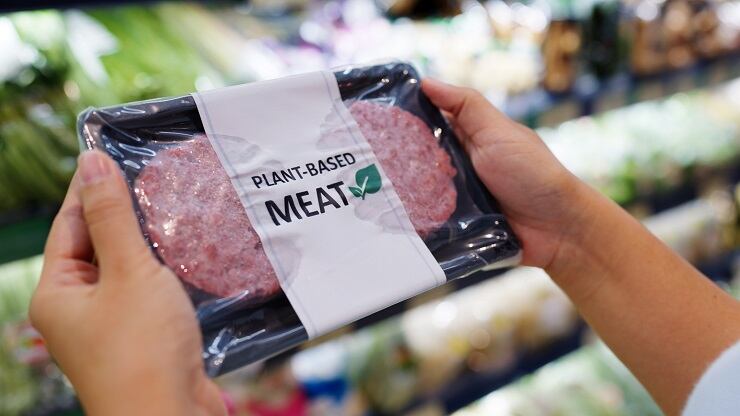During Tufts University’s Cellular Agriculture Innovation Day conference in Boston last week, Bruce Freidrich, founder and president, The Good Food Institute, advocated for long-term, low-interest government loans and scientific collaboration to stimulate private investment in plant-based and alternative protein production.
“We need to keep doubling down on more and more science, and more advocacy to governments to move in this direction. [GFI’s] scientists are integrated in all six areas of the world that we operate with government scientists, and we are getting policymakers enthusiastic about alternative proteins … for the … benefits it can bring,” he said.
He continued, “This is the one solution to foods, climate and other adverse impacts that is analogous to renewable energy and electric vehicles. It’s the one thing where if government gets the industry started, the private sector can take over, just like renewable energy [and] electric vehicles, and governments are starting to wake up to that.”
COP 28 elevated alternative proteins, cellular agriculture as viable environmental, nutritional solutions
Echoing COP 28’s focus from last November in Dubai, Friedrich emphasized global impact of alternative proteins and cellular meat in building sustainable food systems for a healthier planet and global population with government support.
Research around the environmental impact of alternative proteins is promising. During the COP 28 conference, the UN Environment Program released its report endorsing alternative proteins’ role on improving global health, biodiversity and reducing emissions. The report focused on three types of alternatives: plant-based meats, cultivated meat from animal cells and protein-rich foods derived from microorganisms via rapid fermentation.
The report concluded that novel alternatives would address food scarcity and nutrition issues worldwide, reduce the risk of zoonotic diseases and minimize pollution and waste, underscoring the need for government support in conjunction with transparent research.
Hybrid meats offer ‘short-term’ solution towards cultivated meat
While some consumers are skeptical of cultivated meat, Friedrich suggests hybrid products — a blend of plant-based proteins with cell-based or traditional meat — as an economical short-term solution until space is created in the market for more protein varieties.
“We’ll see more of these hybrid approaches as a shorter term or economically viable path to get us to where we need to go. Eventually, we’re all going to need it. We’re going to need every kind of alternative protein, every kind of plant-based and obviously cell-based for nutrition and quality and so on,” he elaborated.
USDA funds first-ever cellular agriculture research center at Tufts
Sanah Baig, USDA’s undersecretary for research, education and economics (REE), remarked that cellular agriculture “really fits into USDA’s vision for the future of food and our agricultural systems.”
In a historic move, USDA-NIFA’s Agriculture and Food Research Initiative's Sustainable Agricultural Systems (SAS) program invested in cultivated meat research in 2021, granting Tufts University a five-year $10m grant to launch the National Institute for Cellular Agriculture, the first US government-funded cultivated protein research center.
The institute coordinates cellular agriculture R&D among 32 researchers and eight universities to “serve as an accelerator for developing a cell culture meat platform through the integration of physical, biological and social sciences,” Baig said.
Current research at the institute explores economical serum-free growth media, creating cell lines for underexplored species and conducting nutritional and flavor assessments of cell-cultivated fat.
Baig elaborated on the institute’s progress in the last year, which includes “13 peer-reviewed manuscripts, establishing the first and only publicly-available fish muscle cell line from the Atlantic mackerel and using AI to develop media scaffolds and other biomaterials.”
Research has progressed in areas around bovine and mackerel cell lines, which “significantly lower the barrier to entry for new researchers [and] improve the reliability and reproducibility of results and enable even further research” Baig noted.
“By supporting robust cell line development, USDA will also continue to advance the field’s tools, knowledge and collaborative potential,” she said.
USDA: Novel foods, protein sources esential for future food system
Further, USDA’s Science and Research Strategy 2023-2026 outlines R&D to diversify the US’ future food systems by expanding novel foods, protein sources and nutrients beyond traditional agricultural commodities.
Since FY 2021, USDA invested more than $37m in R&D for alternative proteins, including cultivated, plant-based and fermentation-based proteins. The USDA’s extramural funding agency, National Institute of Food and Agriculture (NIFA), which provides competitive and capacity funding for R&D at public and land-grant universities across the country, also contributed upwards of $17m to USDA Research, Education and Economics.
“It’s important to know what agriculture looks like today, so we can design appropriate solutions,” Baig said, citing the decrease of farms in the US from seven million in 1935 to two million in 2022, and the loss of 141 million acres of farmland “which we will never get back.”
She continued, “The model of agricultural production that was really set into motion in the late 70’s, early 80’s valued hyper efficiency over competition, over resiliency and in many cases, over safety. And we know that the resulting system is unsustainable.”
USDA’s “sweeping action to tackle structural competition issues in the agricultural supply chains to create fairer, safer … ag markets, and cellular agriculture R&D is really a key part of this entire work,” Baig emphasized.
With President Biden’s 2022 executive order promoting efficient protein production systems and USDA's data-driven goals for climate and food innovation, Baig emphasized that “we will need cellular agriculture" to achieve these objectives.


![[Video] Investors ‘wake up’ to reality of food-tech investments, turn attention to sustainability](https://www.foodnavigator-usa.com/resizer/v2/NFSZBNG6PRPJXG5T5NHBQDI2C4.png?auth=8b4ef1ca1dc4f95cd03ba1126f0167c41411e40a8f8a46cf4441bd9f75337a6e&smart=true)

